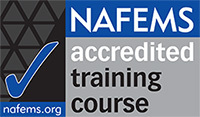| V&V-SIMMsy9 | Design a test for analysis validation purposes. |
| V&V-SIMMsy8 | Formulate a series of smaller studies, benchmarks or experimental tests in support of a simulation modelling strategy. |
| V&V-SIMMsy7 | Prepare a validation plan in support of a FEA study. |
| V&V-SIMMkn6 | State simulation V&V principles |
| V&V-SIMMkn15 | List relevant physical tests and their characteristics to calibrate or validate simuation. |
| V&V-SIMMev8 | Train engineering staff in validation techniques |
| V&V-SIMMev7 | Design appropriate verification and validation procedures in support of simulation. |
| V&V-SIMMev11 | Design test/analysis correlation processes, and select analysis validation criteria. |
| V&V-SIMMev10 | Assess model/analysis validity from test/analysis correlation studies |
| V&V-SIMMco9 | Explain the term model calibration. |
| V&V-SIMMco8 | Explain the term code verification. |
| V&V-SIMMco7 | Explain the term solution verification. |
| V&V-SIMMco6 | Explain the terms Verification and Validation. |
| V&V-SIMMco32 | Understand simulation error assessment methodologies and the concept of simulation predictive maturity. |
| V&V-SIMMap6 | Perform test /analysis correlation studies |
| V&V-SIMMap5 | Perform model calibration from tests |
| V&V-SIMMap4 | Perform basic model checks |
| V&V-SIMMap3 | Conduct validation studies in support of simulation. |
| V&V-SIMMan7 | Analyze test data to support validation activities |
| V&V-SIMMan6 | Analyze simulation results to support validation activities. |
| PROBkn8 | List types of uncertainty |
| PROBkn5 | List typical random sampling techniques. |
| PROBkn3 | List the characteristics of a typical probability distribution |
| PROBkn10 | List the benefits from probabilistic finite element analysis. |
| PROBkn1 | List typical sources of uncertainty in a reliability assessment |
| PROBco9 | Explain the relationship between the Normal Probability Density Function and the Cumulative Density Function. |
| PROBco8 | Explain how probabilistic sensitivities can be used to guide product design. |
| PROBco7 | Describe how variability in an analysis input quantity may be characterised. |
| PROBco2 | Describe the difference between epistemic and aleatoric uncertainty and how they can be quantified |
| PROBco11 | Describe Monte Carlo simulation. |
| PROBco1 | Explain the term non-deterministic. |
| MG-SIMMsy15 | Implement efficient versioning process for the simulation tools used by your company. |
| MG-SIMMev9 | Evaluate and benchmark external supplier validation approach |
| MG-SIMMev14 | Assess simulation solution maturity and readiness levels for a new project. |
| MG-SIMMco33 | Understand software versioning processes |
| MG-SIMMco1 | Understand the need and relevance of analysis specifications. |
| MG-SIMMap25 | Apply appropriate procedures for controlling the quality of simulation work |
| MG-SIMMap18 | Monitor tool (code) verification for the relevant project and intended use |
| MESMev1 | Select appropriate validation measures. |
| MESMco9 | Discuss the uncertainties typically present in analyses and explain how these are handled. |
| FEAsy8 | Prepare a validation plan in support of a FEA study. |
| FEAkn4 | Define the meaning of adaptive mesh refinement |
| FEAkn13 | State the word length or arithmetic precision of calculations for any system used. |
| FEAev5 | Manage verification and validation procedures in support of FEA. |
| FEAco3 | Explain the term solution residual. |
| FEAco12 | Outline a common method employed to solve the large sets of sparse symmetric common in FEA. |
| CFDsy3 | Formulate a plan to address the uncertainty in input data or modelling when using a CFD code for a design study. |
| CFDkn7 | List the main sources of error and uncertainty that may occur in a CFD calculation. |
| CFDco12 | Review the issues associated with the estimation of total uncertainty in a flow simulation. |



